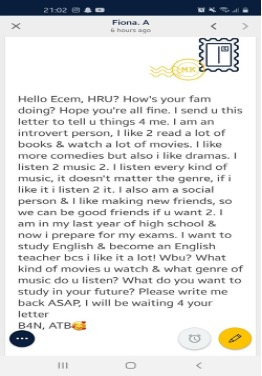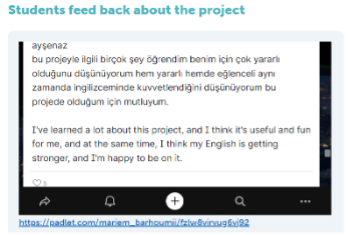
Using eTwinning to improve learning outcomes when teaching English in rural areas
Since the Covid-19 pandemic, traditional education systems have been extended to include modern technology. And this has given us the opportunity to develop professional skills through eTwinning. We asked Aysen Demir Aygün to explain what eTwinning is, and how educators can use it to engage students.
General Aspects of eTwinning: “The community for schools in Europe”
eTwinning is the community for schools in Europe. It offers a platform for staff (teachers, headteachers, librarians, etc.), working in a school in one of the European countries involved, to communicate, collaborate, develop projects, share and feel, and be part of the most exciting learning community in Europe – the School Education Gateway.
Two teachers from different countries create a project idea and present it in brief to the platform. After that, the project is ready to start, and welcome new partners! Whatever your project idea, the basic aim is to create a simple, student-based proposal. Through this platform, any school in Europe can use ICT to exchange ideas with another school, establish pedagogical partnerships, and share good practices (Papadakis, 2016; Pham, Klamma & Derntl, 2012). This is a great way for professional development among teachers, especially for the ones who work in rural areas with limited resources.
The evidence from (The Center for Innovation in Education in Romania) TEHNE evaluation report suggest that:
- 35,4% of the teachers surveyed from the rural area attended online course
- 43,6% of the teachers investigated used the eTwinning portal for continuous professional development; after attending the eTwinning program
- 75,2% of the teachers surveyed from the rural area are putting more accent on using ICT support tools in their teaching. (Scoda, Andreea- Diana)
There is no time limit on eTwinning projects. Of course, the project has a time schedule but project partners can extend the date. Some projects have only three months duration some have one year. You can adapt your project according to your goals or in the event of unexpected circumstances, you may change it completely. During the pandemic, we had to take a two-month break on all projects, and later we extended the deadline.
eTwinning projects bring together language learning, digital literacy, ICT use, and science and mathematics, as well as various social sciences (European Commission, 2013), encouraging active student participation. They learn, implement, and use ICT tools and – even learn new languages – through different project types. Most importantly, pupils meet their European friends regularly, even if only online. Maybe for the first time in their lives, they meet different cultures and people. This is a wonderful opportunity.
Quality Evaluation and Awards for a Successful eTwinning
After your project has been completed and submitted, there are quality labels that indicate the project has reached a designated national and European standard.
At the first level, if you fulfill the following criteria you are awarded a National Quality Label (after applying to your National Support Service within their deadline).
- Your eTwinning project has common goals and a shared plan
- It is finished or in its last stages
- You and your students have contributed to all the project’s activities
- You and your partners have organised collaborative activities
- You have taken into consideration data protection and copyright issues
All projects are evaluated by taking into account these five criteria. (European School Net) If your project is outstanding, teachers and students may receive the ultimate honor: the European Prize.
Teaching English through eTwinning!
Today English as a lingua franca (ELF) is a sine qua non in various aspects of life, including human relations, international, political, and business affairs, technology, and education all over the world. (Kemaloğlu, Şahin, Muazzez, 2022) That’s why English language teaching is necessary for international communication skills, the use of digital tools, and global opportunities like eTwinning projects.
As a dynamic English teacher for eight years, I have been teaching English as a second language in remote areas. As an active eTwinner, I can easily compare the effectiveness of integrating eTwinning projects with my lessons through my experiences as there is little research about English teaching in rural areas with examples.
The quality of language teaching differs significantly in rural and urban areas. Teaching a language as a second language can be harder in remote areas for pupils with prejudice against learning a language, limited resources for language acquisition, and a lack of parental interest. Even though the same curriculum and policies are implemented in rural and urban areas in education in Turkey, this system does not always match with the interests or cultural or social differences in the rural areas and fails to supply knowledge that is discernible and relevant to all students. (Çiftci and Cin, 2017 )
Also, in rural schools, we are dealing with poverty and transportation hardships. Teachers must prioritise improving relationships with families and other communities to get attention and provide financial services for education.
As Şahin (2021) states, rural teachers often get demotivated by the limited conditions of their environment identified as technological deficiencies, defects in school buildings, inadequate resources, and lack of opportunities for professional development. This makes everything harder for teachers in rural areas. But schools are a source of life for pupils. That’s why as educators we have to create healthy and fruitful teaching environments for them. According to the report published by The Organization for Economic Cooperation and Development (OECD, 2012), children from disadvantaged environments can take advantage of skills and strategies learned at schools which are especially more difficult for them to acquire at their homes.
The solution for all these challenges is absolutely eTwinning!
Before I ran my eTwinning projects, nearly half of my students got demotivated by English lessons and the use of English in practice and digital tools. However, after three years, the number of my students who were willing to speak English in front of the community doubled. eTwinning gives courage to pupils to practice English as the main focus is not the English lesson, but rather enjoying time with their peers and learning at the same time.
eTwinning in my Classroom



I keep a good number of students focused on my English lessons with interactive activities and the effective use of eTwinning. My first project in eTwinning is “Let’s be Safe Digital Users on Social Media”. I ran the project with five partners from Europe during the pandemic. Pupils researched and used social media to make it better and safer. They learned to use digital tools and be safe users at the same time. They made friends from all over Europe and started to chat in English with one another in their daily lives.
At the end of the project, they made a presentation for their peers. It gave me a chance to observe my pupils during the whole process and see how they became confident speakers!
The powerful impact of this new generation project platform changed and shaped my perspective towards eTwinning. The projects I run helped my pupils raise their awareness of English as a communicative tool rather than a subject to be studied. It improved not only their language skills but also active participation, collaboration, self-confidence, individual and social values, and relationships with their peers and teachers around Europe.
Since I started carrying out eTwinning projects with European partners, my project language has always been English. It helps my students use English in a non-formal environment with native speakers. They meet their peers through the project and get in touch online. Some even become close friends and keep communicating through social media. This is a great opportunity for students with a limited social life in their small province. The pupils whom I work with in my eTwinning projects have developed their English speaking skills to a great extent.
Still, it has some pitfalls in rural areas. Although teachers can shape or design the activities for students according to their needs and conditions, for a pupil in a remote school, the internet connection can be problematic. In that case, virtual activities can be held with concrete materials so that students can be included. Afterwards, in their project “twinspace”, teachers or designated students can add their works in scope with the project schedule.
Student feedback on eTwinning


As they make new friends through eTwinning projects, students’ social skills develop and they gain problem-solving skills, learn to work and produce together with a team, develop a project culture, and gain ICT skills, their competence in Web 2.0 tools develops and their digital literacy increases (Acar, 2021), their self-confidence improves, and their willingness to learn a foreign language increases.
eTwinning projects motivate students and contribute to students’ language learning as well as deep learning (Demir & Kayaoğlu, 2021; Fernández & Tena, 2013; Leto, 2018).
This research shows that eTwinning has a highly positive effect upon teachers in terms of professional development – not only for their linguistic development but also digital competencies.
I’m Jale, from Turkey. I was really shy to take part in the project at first. I barely could express myself with my peers online. It was lockdown. We were all at home. During the project, we joined all online activities and really enjoyed them. I both developed my English skills and got some confidence to make presentations. It’s a great pleasure for me to be an eTwinner.
Teachers can benefit from this perception to increase motivation, broaden the students’ perspectives, and lead them to improve their interpersonal relations along with language skills (Hardré et al., 2008). In doing so, they can develop and apply novel methodologies for their students including project-based language learning. (Kemaloğlu, Şahin, Muazzez, 2022)
Conclusion
Even if conditions are not the same for a pupil who lives in a village or in a big city, technology helps educators involve these students through design-driven projects like e Twinning which doesn’t require physical mobility. There are no limitations in terms of content, number of participants, means of communication, languages of communication, time limits, and forms of assessment. Digital technology is seen as a means to implement various pedagogical approaches (Gajek, E.).
Last but not least, eTwinning enables students to acquire 21st-century skills, develop a project culture, improve their use of technology, boost their self-confidence, social skills, and motivation, and ease foreign language learning. They also build communication and cooperation between schools, students, and teachers at national and international levels, bring technology integration into classroom environments, and contribute to the spread of a European culture among them. (Gökbulut, 2023)
Key Messages
- Students in remote areas often don’t have the opportunity to socialize, and eTwinning enables students to make new friends all over Europe.
- Teachers can use eTwinning to work with other European teachers on a project in a range of subjects.
- eTwinning provides students with an opportunity to practice English skills actively while developing ICT skills.
- eTwinning develops ICT skills.
- eTwinning is an excellent and practical tool for professional development for teachers.

Ayşen Demir Aygün
Coordinator of eTwinning and Erasmus Projects, R&D Dept, Directorate of National Education, Türkiye
Ayşen DEMİR AYGÜN as a lifelong learner, educator, dedicated eTwinner has been teaching English for nine years in Turkey. She graduated from Hacettepe University and got her MA in Translation Studies in 2021. She has been the coordinator of eTwinning and Erasmus projects in the R&D department in the Directorate of National Education since 2018. She is a team member and content developer for the Educational Magazine of the Directorate. She volunteers in many non-governmental organisations for educational purposes and youth work.
Other blog posts on similar topics:
Cin, F. M. (2017). What matters for rural teachers and communities? Educational challenges in rural Turkey. Compare: A Journal of Comparative and International Education, 48(5), 686-701. https://www.tandfonline.com/doi/full/10.1080/03057925.2017.1340150
Ҫakıroğlu, E., & Ҫakıroğlu, J. (2003). Reflections on teacher education in Turkey. European Journal of Teacher Education, 26(2), 253-264. https://doi.org/10.1080/0261976032000088774
Çiftçi, Ş. K., & Demir, N., & Kayaoğlu, M. N. (2021). Multi-dimensional foreign language education: The case of an eTwinning project in Turkey. Computer Assisted Language Learning, 1-38. https://www.tandfonline.com/doi/full/10.1080/09588221.2020.1871027
European Commission, (2013). Education for Change. Final Report—Study of the Impact of eTwinning on Participating Pupils, Teachers and Schools; Publications Office of the European Union: Luxembourg. https://op.europa.eu/en/publication-detail/-/publication/ec23d4e3-e305-4d1c-83da-1989d35ec7e0
Gajek, E. (2006). eTwinning Europejska współpraca szkół Polska 2006 /European Partnerships of Schools Poland 2006. Fundacja Rozwoju Systemu Edukacji https://kometa.edu.pl/uploads/publication/726/263b_AA_etwinning.pdf?v2.8
Ghimire, B. (2022). Blended learning in rural and remote schools: Challenges and opportunities. International Journal of Technology in Education (IJTE), 5(1), 88-96. https://doi.org/10.46328/ijte.215
Gökbulut, B. (2023). A Study To Determine The eTwinning-Related Views Of The Teachers In The eTwinning Network Countries, And Their Digital Literacy Levels, Journal of Teaching https://dergipark.org.tr/tr/download/article-file/2759475
Kemaloglu-Er, E., & Bayyurt, Y. (2019). ELF-awareness in teaching and teacher education: Explicit and implicit ways of integrating ELF into the English language classroom. In N. C. Sifakis, & N. Tsantila (Eds.), English as a lingua franca for EFL contexts (pp. 159-174). Bristol: Multilingual Matters. https://www.researchgate.net/publication/327977630_ELF-awareness_in_teaching_and_teacher_educationExplicit_and_implicit_ways_of_integrating_ELF_into_the_English_language_classroom
Scoda, Andreea, Diana. The Impact Of Implicating Teachers From The Rural Area In Using Ict Skills And Tools – A Milestone. Carol I National Defence University Publishing House. https://www.ceeol.com/search/article-detail?id=105105
eTwinning National Quality Label https://school-education.ec.europa.eu/en/recognition/etwinning-national-quality-label
eTwinning – the Community of Schools in Europe https://www.schooleducationgateway.eu/en/pub/resources/tutorials/etwinning–the-largest-commun.htm
EU report on new eTwinning group of small and remote rural schools https://school-education.ec.europa.eu/en/insights/news/new-etwinning-group-small-and-remote-rural-schools
